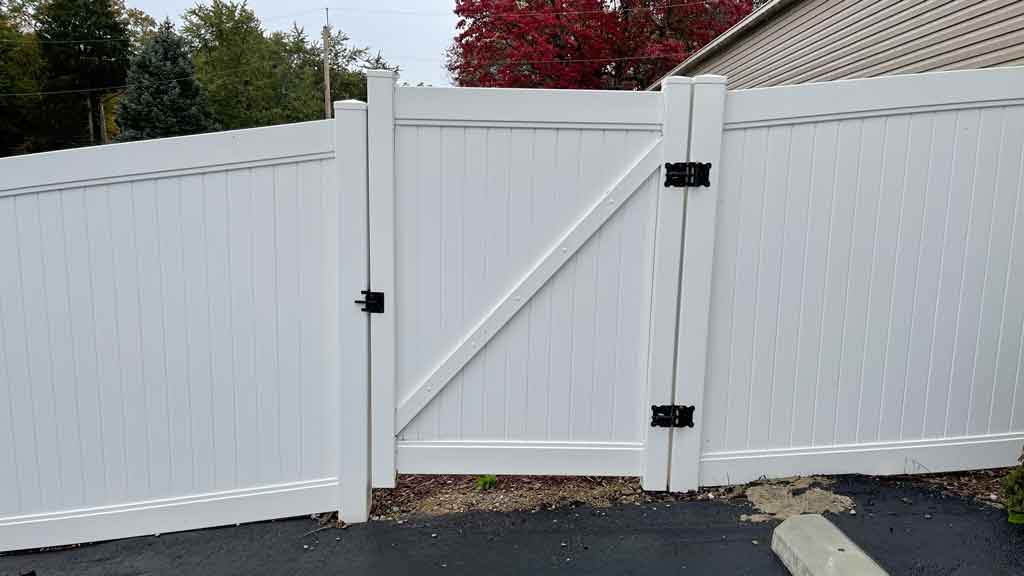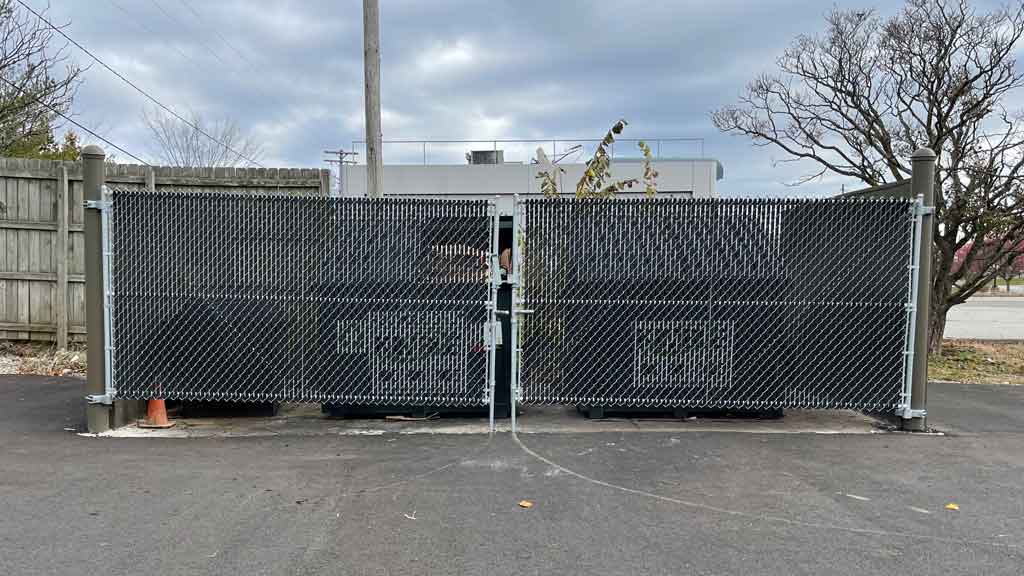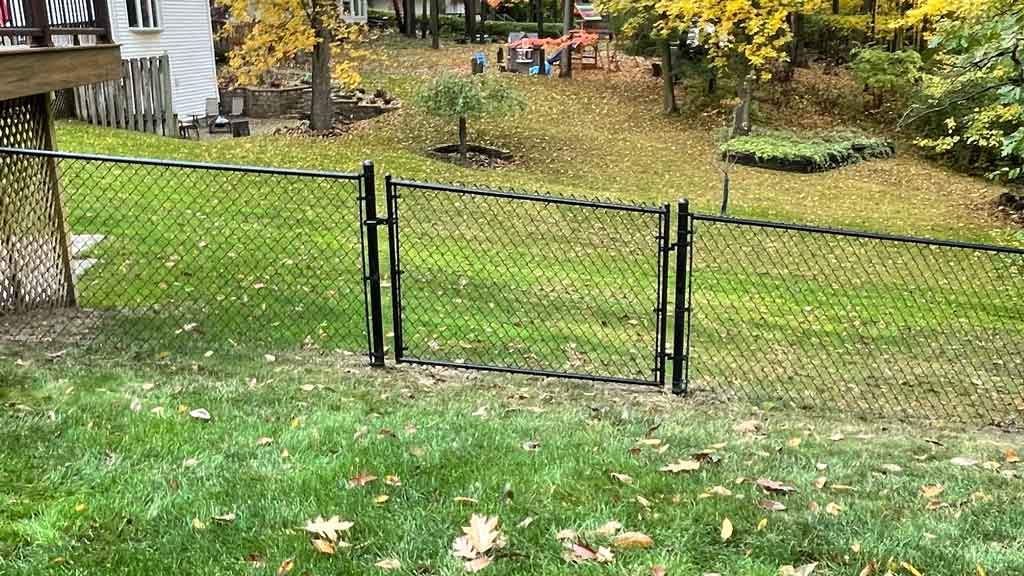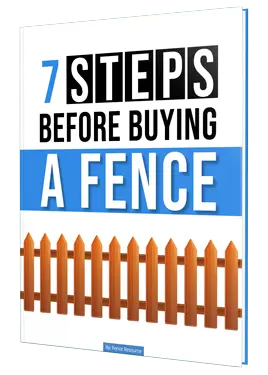Installing gates on a slope is not ideal. In a perfect world, every gate installed would hang nice and level in a location that is also flat and level. However, this isn’t a perfect world and most yards have grade changes to prevent drainage issues. As a result, leaving yards and driveways with slopes to contend with.
So what if the only location you have for a gate is on a slope? Can it be done? How will it look? Will it operate correctly? These are all valid questions that we will address in this article about gates on a slope.
Furthermore, we will take a look at how the direction of the slope effects how the gate must hang and or operate. So let’s dive in by first defining what a slope is and the two types of slopes based on their relation to the fence line.
Fence on an Easement – Can You Build One?
Types of Slopes Effecting Gate Operation and Placement
There are two specific types of slopes that need defined. Each one effects how a fence gate will hang and operate. For the sake of explaining the two types, let’s assume we are looking at the gate from the outside of the fence and that the gate is in the closed position.
The first type of slope will run parallel to the fence and gate when in the closed position. This means that when looking at where the gate and fence will go, the slope runs left and right.
The second type of slope will run perpendicular to the fence and gate. Therefore, this means that the slope will run forwards and backwards.
Gates on a Parallel Slope

The direction of the slope determines what side to hinge the gate on. For gates installed on parallel slopes, the gate should always hinge from the low side.
The reason being, the distance between the bottom of the gate and the ground underneath it will grow as the gate opens. This allows the gate to function freely.
When a gate hinges from the high side of a slope, the distance between the bottom of the gate and the ground decreases when opening. As a result, your gate would not open much more past perpendicular. So always hinge the gate from a post on the low side of the slope.
Gates on a Perpendicular Slope
Just like parallel slopes, perpendicular slopes also determine the direction a gate must swing. In this scenario, the gate should always swing towards to low side of the slope.
Just like the gate swinging away from the high side on a parallel slope, a gate swinging away from the high side on a perpendicular slope will also provide more distance between the bottom of the gate and the ground when opened.
If the gate were to swing towards the high side of the slope, it would result in the gate dragging the ground before it was ever fully able to open. That is unless the gate is elevated enough to allow clearance. However, at that point, the space below the gate would be much higher than acceptable for most applications.
Even when the slope is subtle enough that you may not think it matters, it does. When grass gets long, or winter comes and snow accumulates, every extra inch of clearance matters.
Types of Gates on a Slope

We just learned how the type of slope impacts what side a gate should hinge on and the direction is opens. But what changes when the type of gate changes? Is there a difference between a single man gate, a double gate or even driveway gates on a slope?
For single gates, the answer remains the same. The slope of the land determines what direction the gate swings and what side to hinge it on. However, other factors effect double gates and driveway gates on a slope.
Double Gates on a Slope
A double gate is two single gates that meet in the middle without the need of a center support post. This means that one gate will have to hinge on the low side as recommended above. However, this means the other gate will have to hinge on the post located on the high side of the slope.
If you absolutely have to have a double gate and it absolutely has to be located on a slope, there are a few potential issues that will come into play.

The Problem with Double Gates on a Slope
First, as discussed, the gate hinged on the high side of a parallel slope will most likely not open much past 90 degrees. Being that this is a double gate and the other side of the gate would work better as the everyday gate, this probably won’t be a problem to most.
Second, and probably a problem for most, is the amount of space (or gap) created beneath the low side of a double gate when on a slope. Here’s what happens. Say you have a 10′ wide double gate. The first gate hangs about 2″ off of the ground on the high side of the slope.
The gate hangs level, but the slope drops one half of an inch per foot. That means in order to hang the second leaf of the double gate at the same height as the first, there will be an additional 5″ of space underneath it. Add that to the 2″ of space already accounted for so that gate will operate correctly and you now have a 7″ gap under the low side gate.
That amount of space is normally too much for customers to live with. Either because they have a pet they are trying to contain or because they simply do not care for the look.
The Solution to the Problem
There are two ways to fix the above mention problem with double gates on a slope. Neither solution is perfect, but they are functional.
The first way is add fill underneath the gates where the gap is too high. If you just had your yard fenced, you will have plenty of dirt. Most fence companies do not haul away the dirt spoils from the fence holes. However, they should offer to relocated on your property. At this point, you could build up the grade to help reduce the gap.
The second method requires stepping the gates where they meet in the middle. Instead of both gates being level across their entire width, the gates would step down a few inches in order to reduce the amount of space under the low side.
Neither one of these solutions looks pleasing. However, they are solutions if a double gate on a slope is a must.
Driveway Gates on a Slope
Driveway gates on a slope offer a unique set of circumstances. For the most part, wether they are single gates or double gates, the same rules apply as explained above. The one major difference however is when a driveway gate is forced to swing in a particular direction. This is a result of not having enough room to swing it in the opposite direction.
We’ll assume that most driveways are pretty level from left to right. So the slopes we will use in our examples are a perpendicular slope.
Not Enough Room
In scenario one, the driveway gate on a slope is out by the sidewalk. The slope of the driveway is higher towards the direction of the house. The problem is the gate cannot open outwards towers the street because there is not enough room for a car to pull into the driveway without interfering with oncoming traffic.
So what can you do?
One option is to raise the gate high enough off of the driveway in order for the gates to swing inwards towards the house. The problem then becomes the gap under the gates if you are using the gate to try to contain something.
If you’re not, then this solution will work. If you are, it doesn’t. At this point, swing gates will not work. A sliding gate for cantilever gate will be the only option to give you enough room to pull a car off the street and keep the bottom of the gate close to the ground.
Electric Gate Operators
In scenario two, you’ve fenced the perimeter of your property or business and want to automate the gate using electric gate operators. Operators are normally installed on the inside of the gate. This keeps them free from being tampered with. As a result, they will pull the gate (or gates) inward to open.
When the slope is uphill, the same problems occur as did in the first scenario. Therefore, a different type of gate is required. That is, unless having your gate operators installed on the outside of the fence is acceptable.
And also assuming you have adequate room in the driveway to pull up close enough to the gate but still provide enough room for the gates to swing towards entering vehicles.
Special Custom Gates Designed for Slopes
There is one last option for gates on a slope. However, not all fence manufacturers will offer them. Furthermore, they will not work with every type of fence material. These are special designed racked gates.
Racked Gates on a Slope

Custom racked gates are built to the exact change in grade of a parallel slope. They are harder to build and therefore will cost more money.
The advantages of racked gates are that they flow with the change of grade better. As a result, there are no larger than normal gaps under them. They also are more esthetically pleasing.
Racked gates still require hinging from the low side of the slope in order to operate. Therefore, they are only good for single gates. A racked double gate will not work.
Conclusion
As you just learned, gates on a slope pose some challenges. If an option to avoid installing one is available I recommend it. However, if it is a must, you now know what to expect, how it will have to hang, the direction it will have to swing and you should be able to envision how it will look.
Click here for information on Installing Fence on a Slope

